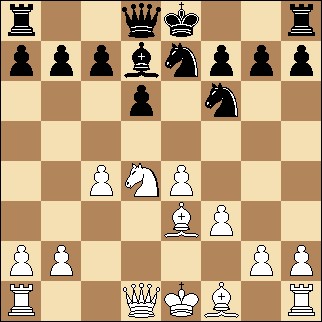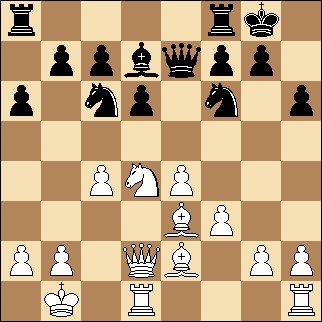Holme Valley v Netherton 1 (White Hart), 10/14/2008
[A27]
|
1.c4 e5 2.Nc3
Nc6 3.Nf3 d6 Black
is attempting a Closed Sicilian reversed. But White can play more actively than Black does in the Closed
Sicilian. 4.d4 ! most forcing. 4...exd4 | ||
|
[4...Bg4 has been played most often, but 5.d5 Nce7 6.e4 is 65% White] | ||
|
5.Nxd4 Now Black has no e5 strongpoint
in the centre and his King Bishop is unable to develop to c5 or b4 (as in Smyslov or Breyer's defence). 5...Bd7 Black avoids doubled pawns, and has the possibility of switching the Bishop to c6, with pressure on e4. | ||
|
[5...g6 looks best, but 6.e4 is 65% White.] | ||
|
6.e4 Be7 Having
no future on c5 or b4 Black prepares to play his Bishop to f6. However this has a drawback, compared
to the fianchetto as we shall see. | ||
|
[6...g6 7.Be3 Bg7
8.Be2 Nf6 9. | ||
| 7.Be3 Bf6 | ||
|
[7...Nf6 8.Be2
| ||
|
8.Nd5 This forces the removal of Black's
dark squared Bishop, which would not have been possible with the fianchetto. 8...Nce7 This ensures Black's rapid development, and gain of tempo with an attack against the e4 pawn. | ||
| [8...Nxd4 9.Bxd4 Bxd4 10.Qxd4 is to White's advantage, but is better than the game.] | ||
9.Nxf6+ Nxf6
10.f3  Now I'm happy with my position. I have a bind on the position, and an unchallenged dark squared Bishop with which I hope to cause Black dark square problems. Also I will soon be able to castle Queenside, and then execute the "spike" attack of g4 to g5 (or h4 then g5). 10...h6 ? Presumably Black didn't like White playing Bg5, but this doesn't help the dark squares at all - in fact it makes them worse as Black must always beware a sacrifice on h6. Also it will now make the "spike" even more effective ! 11.Qd2 Nc6 12. 13...a6 I'm beginning to suspect that Black is scared to castle. - I don't blame him, as a storm is waiting to break on the K-side ! 14.Be2 The Bishop appears better here than on d3, as then Ne5 is annoying. Also the Bishop defends f3, which will be weakened after the spike move. It also defends c4 and X-Ray defence of g4 14...  At last Black commits himself. As anyone who has studied middlegame theory knows, when there is castling on opposite wings success goes to the player whose attack strikes first. - Now the spike attack by White ! And a Black counter-attack is nowhere in sight ! 15.g4 ! Every thing's ready and the storm clouds are gathering over the dark squares. 15...Rfe8 This gives Black possibilities of a Knight sack on e4 , followed by Queen check on e4, which also attacks the e3 Bishop. 16.Rde1 Precautionary , Karpov-style - why allow Black counterplay? Now the Bishop d3 interpose is available if Black sacks. 16...Qe5 | ||
|
[16...Nxe4 ? 17.fxe4
Qxe4+ 18.Bd3
Qxg4 19.Rhg1 | ||
|
17.Nf5 ! Now the sack on h6 is ON,
and if Black takes the Knight the g-file will be wide open - Yippee ! 17...Qa5 ? Black hopes White will oblige with a Queen swap, but no cigar ! 18.Qc1 renewing all threats and now Black's Queen is far from the defence of his King. 18...b5 ? Desperately seeking counterplay, but tooooo late, loses quickly, my only problem now is which sack is better Nxg7 or Bxh6 ? 19.Bxh6 | ||
| [19.Nxg7 Kxg7 20.Bxh6+ Kh7 21.Qg5 Rg8 22.Qh4 ! wins the Queen or Black gets mated. But Black doesn't have to capture the knight on the 19th move.] | ||
|
19...g6 only move, according to the
computer. | ||
| [19...gxh6 20.Qxh6 Bxf5 21.gxf5 and it's curtains with Reg1 to follow.] | ||
|
[19...Bxf5 20.gxf5
g6 was Stewart's suggestion, but Black
is lost. There's a thunderstorm on Black's King side. Complete analysis is impossible, but here are some
example variations. | ||
| (20...Kf8 21.Bxg7+ Kxg7 22.Qg5+ Kf8 23.Qxf6 wins) | ||
| 21.fxg6 fxg6 22.Qg5 | ||
|
(22.cxb5 with a discovered attack on the
Knight is also possible. 22...Nd4 23.Qg5 Kf7 24.Bc4+ d5 25.Bg7 Kxg7 26.Reg1 Kf7 27.Qxg6+ Ke7 28.Qg7+ Ke6 29.Bxd5+ Kd6 30.Qxf6+ Ne6 31.Bxe6 Rxe6 32.Rd1+ wins) | ||
| 22...Kf7 23.Rhg1 Ne7 | ||
| (23...Ne5 24.f4 Nh7 25.Qg3 Qd2 26.Ref1 Kg8 27.Bh5) | ||
| 24.e5 dxe5 25.Bd3 Rg8 26.Qxe5 Qb4 27.Qe6+ Ke8 28.Qxf6 wins] | ||
| [19...Nh7 20.Nxg7 White's K-side is in ruins.] | ||
20.Bg7  !! Alekhine would have loved it. What did I tell you about the dark squares ? Every dark square around the enemy King is controlled by White ! 20...Re6 | ||
|
[20...Nxg4 Alekhine frowned, he knew that
sacrificing the Knight so as to prevent an immediate Qh6, and give the King a luft with f6 is the only
attempt at a "defence", but still loses quickly. 21.fxg4 Bxf5 22.Qh6 Bxe4+ 23.Kc1 f5 computer's best defence | ||
| (23...f6 24.Bxf6 Re7 25.Bf3 Rh7 26.Qg5 Black hasn't a move.) | ||
| 24.gxf5 ! | ||
| (24.Bc3 also wins picking up the Queen.) | ||
| 24...Bxf5 25.Bf6 Re7 26.Qh8+ Kf7 27.Qg7+ Ke8 28.Bxe7 Kd7 | ||
| (28...Nxe7 29.Bf3 and mates.) | ||
|
29.Bf3 Re8
30.Bxd6+ is mate in 12 believe it or
not ! 30...Kxd6 31.Rxe8 Qd2+ 32.Kxd2 Kc5 33.Qxc7 Kb4 34.Qd6+ Ka5 35.Bxc6 Bc8 36.Rxc8 Kb6 37.Rb8+ Ka5 38.Qa3#] | ||
|
21.Qh6 Black resigns 21...Nh7 is the
only defence, then 22.Bf8 (or Bishop anywhere), and mate follows. The White Queen, with poetic justice,
settles herself comfortably on the DARK SQUARE g7 !! 1-0 | ||